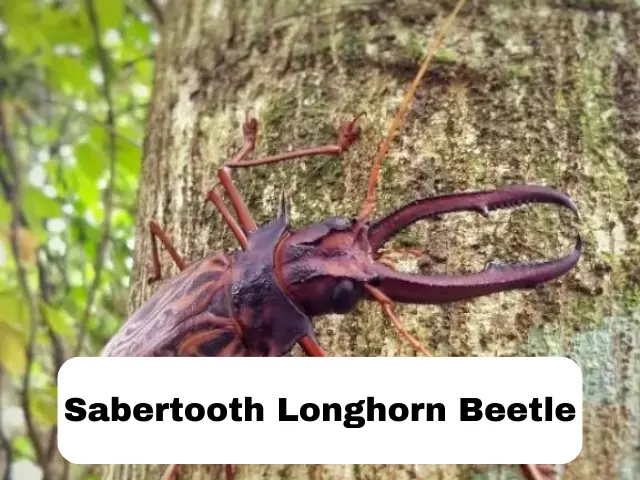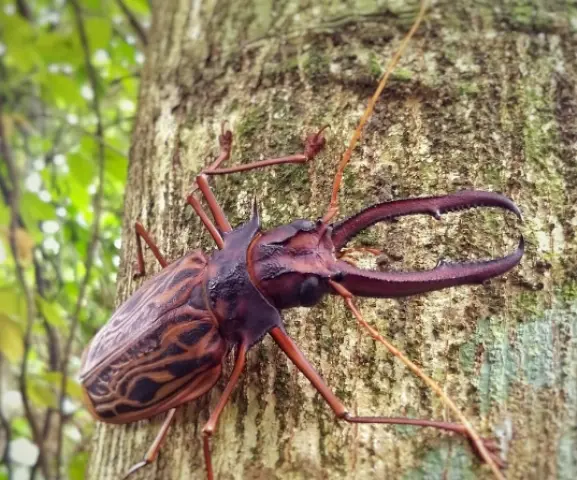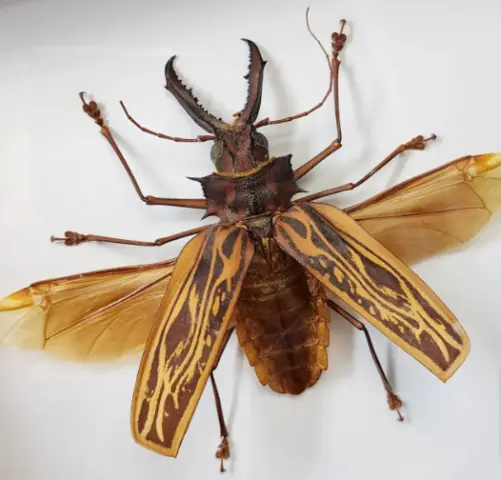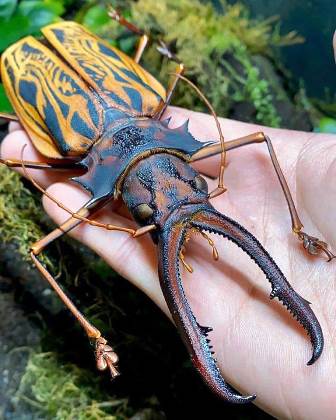The sabertooth longhorn beetle, also known as Macrodontia cervicornis, is one of the longest insects in the world. Males’ jaws, which include serrated teeth, can measure up to 7 in (17.8 cm) in length!
These beetles inhabit humid rainforests in the Amazon River region from Brazil to Ecuador and westward. They are now in danger. Several acres of the Amazon rainforest have been cleared in the last few decades to create room for cattle ranches, soybean farms, and other purposes. A single specimen of the beetles can fetch thousands of dollars. The practice of collecting these long-lived insects is another factor contributing to their demise.
Do you need further details about them? Find out by continuing to read!
Sabertooth Longhorn Beetle Life cycle
Complete metamorphosis refers to the four stages of development that make up the life cycle of the Asian longhorned beetle. Four stages of development that make up the full transformation process are as follows:
· Eggs
The Asian long-horned beetle’s female lays her egg in a notch and bites into a tree’s bark. The female beetle burrows and then lays one egg. One female may produce up to 100 eggs, which she may do by laying eggs at various locations. The freshly hatched larva feeds on the inner tissues of the branch and tree trunks close to the burrow location after the egg hatches. The developing larva twists as it grows and burrows into the center of the tree.
· Larvae
The larva goes through five developmental phases called “instars.” Before beginning the pupation stage that leads to adulthood, they can reach a maximum height of 5 cm. The Asian longhorned beetle overwinters as a larva in the center of the tree as part of its life cycle, which spans from one development season to the next.
· Pupae
Before pupating, the larvae turn and move towards the infected tree’s outer bark. There, they establish into a pupal cavity and continue their development until they reach adulthood. The larva then moves on to the pupation stage, emerging a month later as an adult.
· Adults
Their feeding habits change as they mature into adults, and they stop feeding as frequently as they did before. Adults will keep growing and reproducing from the tree until it gets colder outside or the first hard frost of the season arrives. Late-season eggs may survive the winter as eggs in northern regions. Once the couple has mated, the female will begin the process of gnawing into the tree to lay the egg.
Sabertooth Longhorn Beetle Foods
Since they are herbivores, longhorn beetles avoid eating meat and insects. They spend their entire life on trees. One species of long-horned beetle, the Asian Long-horned Beetle (Anoplophora Glabripennis), has become a threat to hardwood trees in North America, even though most long-horned beetles eat dead wood.
This species’ adult beetles have a special fondness for hardwood trees like maple, birch, willow, elm, poplar, and ash, among many others. These trees’ barks are where they lay their eggs. The hardwood in their immediate surroundings turns into one of the larvae’s favorite diets after they emerge. Other typical items that longhorn beetles enjoy eating include grass, fungi, seeds, nectars, fruits, flowers, twigs, and the stems of smaller plants. They are frequently referred to as beneficial insects because of their capacity to consume dead wood and the insects that live inside of it.
They live and prosper best in deep, dark forests with an abundance of vegetation.
Except for wood, longhorn beetles only consume insects and other types of living things. The majority of beetle species are herbivores, and longhorns are no exception. Beetles are not exclusively plant-eaters, though. Some kinds of beetles, like the Epomis beetles, can consume other insects and amphibians.
Sabertooth Longhorn Beetle Habitat
This beetle was unintentionally imported into North America from its home countries of China, Japan, Korea, and the Isle of Hainan. Adults are drawn to hardwood trees that have recently been cut down, are under stress, or seem healthy. Healthy maple, horse chestnut, birch, poplar, willow, elm, locust, mulberry, chinaberry, apple, cherry, pear, and citrus trees are some of the hosts. It might also target other hardwood tree species.
Also susceptible to infestation include nursery stock, logs, green timber, firewood, stumps, roots, branches, and residue with a diameter of at least half an inch. This beetle has only established itself in the regions surrounding New York City and Chicago. Still, it has been found in packing materials and wooden crates coming from China in several locations across the nation.
Sabertooth Longhorn Beetle Facts
· How do they appear?
Adults are 20–35 mm long and shiny black. The usually black elytra of both sexes exhibit up to 20 irregularly spaced, conspicuous white dots. In both sexes, antennal segments 3–11 had distinct white and black bands and legs with bluish-white textures on the dorsum. The cottonwood borer and this beetle are frequently mistaken in Oklahoma.
· How do they behave?
These beetles are diurnal, which means they are most active between the hours of 8 AM and 12 PM during the day. When compared to days that are cloudy, dull, or chilly, they are generally more active on warmer, sunny days. After becoming attracted to the volatile substances that the host trees emit, the adults of these organisms infest a variety of host tree species.
· What is their mating and reproduction process?
Interestingly, the females’ cuticles emit a sex hormone that both men and females are attracted to. The males seek to perform copulation as they approach the hiding ladies. Usually, between 12 and 6 PM, mating takes place on the host tree’s trunk and branches. Since female beetles have the instinct to copulate several times, either with the same male partner or with different men, the male beetles start to protect the female immediately after successful copulation and frequently continue to do so for several hours.
· How Do They Talk to One Another?
Chemical cues are the main communication means among longhorn beetles. They can communicate visually and chemically by emitting pheromones.
· How do they consume liquids?
Longhorn beetles have a strong preference for water, much like any other creature on the planet. They view wet wood as a reliable supply of this water. Longhorn beetles likely look for moist timber first because of this. The majority of adult longhorn beetles also enjoy drinking tree sap and honey for sustenance.
· What harm do they cause to trees?
Females frequently chew depression in the bark, where they lay up to sixty eggs on average, one to two eggs at a time. After hatching, the larvae consume the living tissue immediately beneath the bark of the tree, disrupting the nutrients and water flow inside the tree. When the larvae are prepared to pupate, they continue feeding deep inside the heartwood. Generation after generation, the tree is repeatedly girded and killed by dozens of larvae. Depending on the site’s conditions and the tree’s general health, tree death often happens 7-9 years after the initial infection.
· Where Can You Find a Longhorn Beetle?
Longhorn beetles come in seven or eight different varieties and are found all over the world. Some of the most prevalent longhorn beetle species nowadays can be found on trees in New York, North America, Africa, Europe, and Asia. In the United States of America, they are widely dispersed.
· What are the concerns related to sabertooth longhorn beetle?
Since Asian long-horned beetles are known to damage maple and many other hardwood tree species in both residential and woodland regions, concerns raised by this pest tree are significant. Contaminated trees must be removed and destroyed, and quarantine zones must be established to prevent the spread of the beetles’ eggs, larvae, and pupae from one area to another.
· What Is the Lifespan of a Longhorn Beetle?
Once completely hatched, male longhorn beetles live for about 50 days. The average lifespan of a female longhorn beetle is 66 days.
· What is its size?
A longhorn beetle typically ranges in length from 0.7 to 1.3 inches (2 to 3.5 cm). Frequently, their antennae are twice as large as their bodies. The long-jawed beetle can grow up to 16 cm in length. However, different insect species come in a variety of sizes. A longhorn beetle is almost 10 times smaller than the dwarf lantern shark.
Conclusion
Sabertooth longhorn beetles stand out from all the species due to their massive size. They spend most of their lives in the larval stage, as they do not survive for a few months as adults. We hope you have known enough about this species and their life from above.
How to naturalize Macrodontia cervicornis, the sabertooth beetle !
MORE POSTS: 10 Insects with funny names that are interesting to know
Priyanki Baruah
Latest posts by Priyanki Baruah (see all)
- Best Monopods for Wildlife Photography in 2023 - October 16, 2023
- Everything You Need to Know About Sabertooth Longhorn Beetle - April 8, 2023
- How much does a baby hippo weigh? - September 19, 2021




